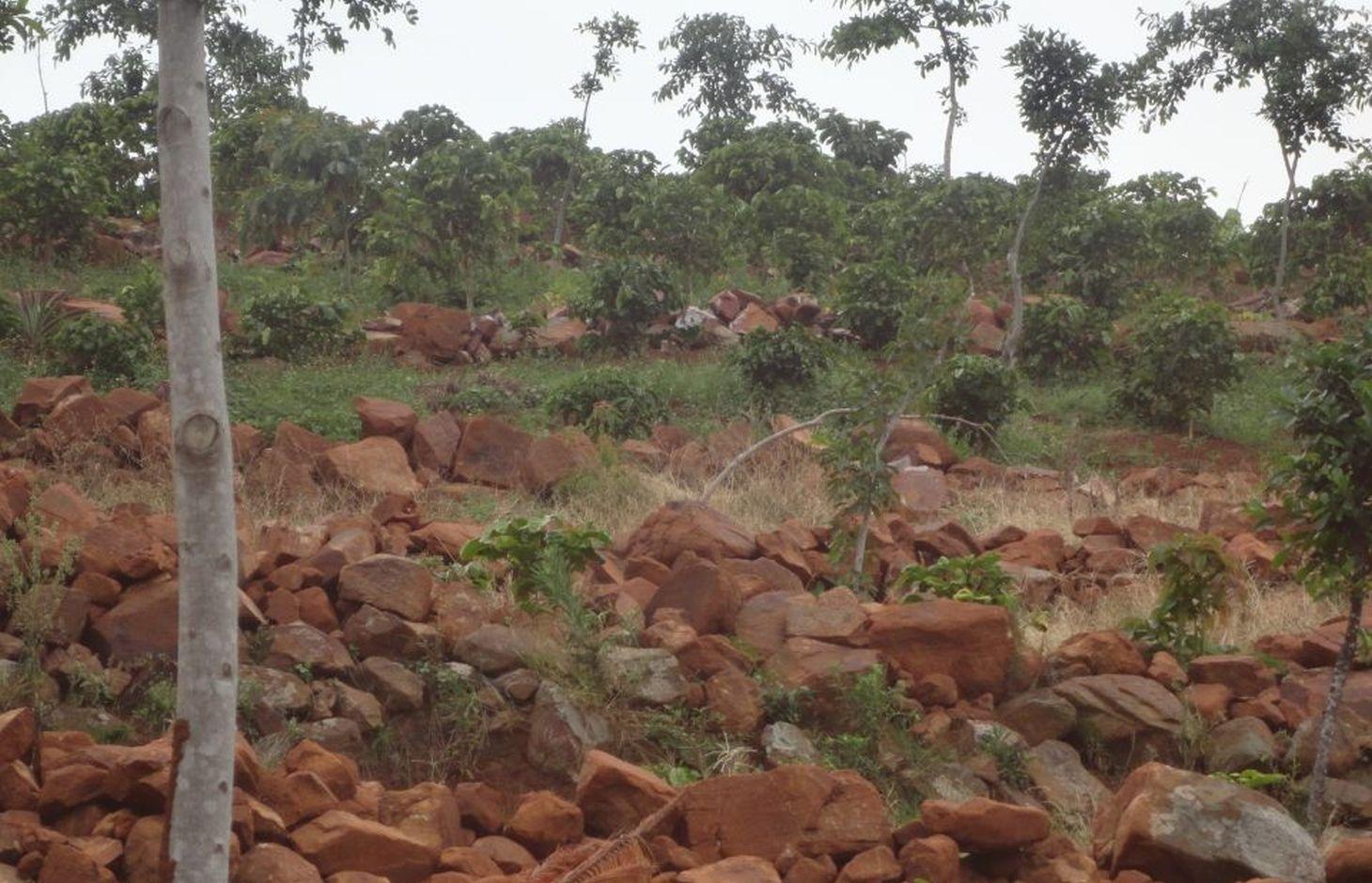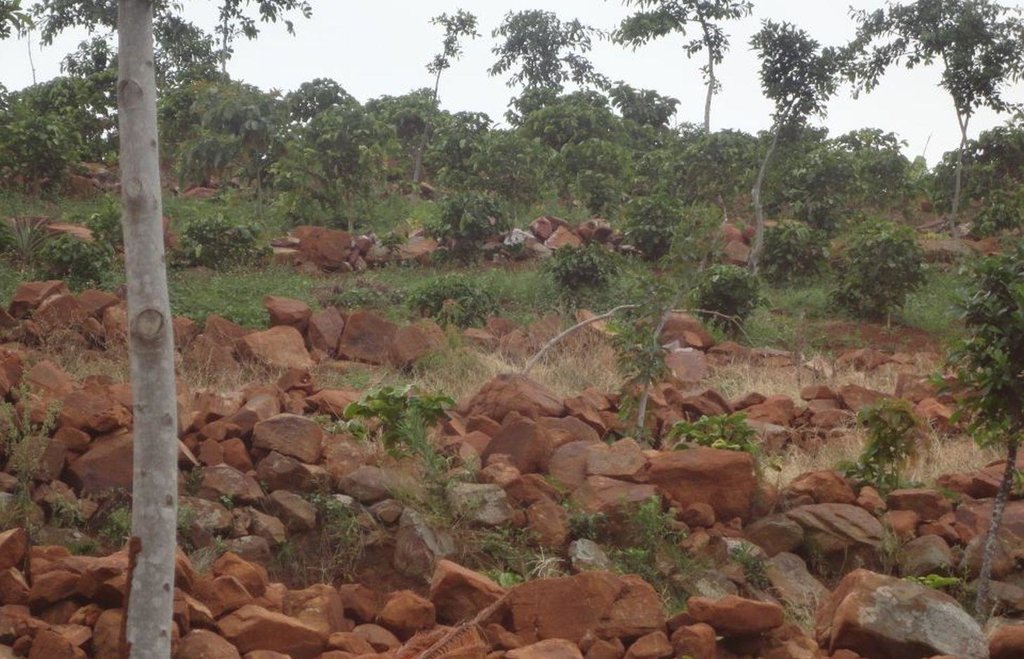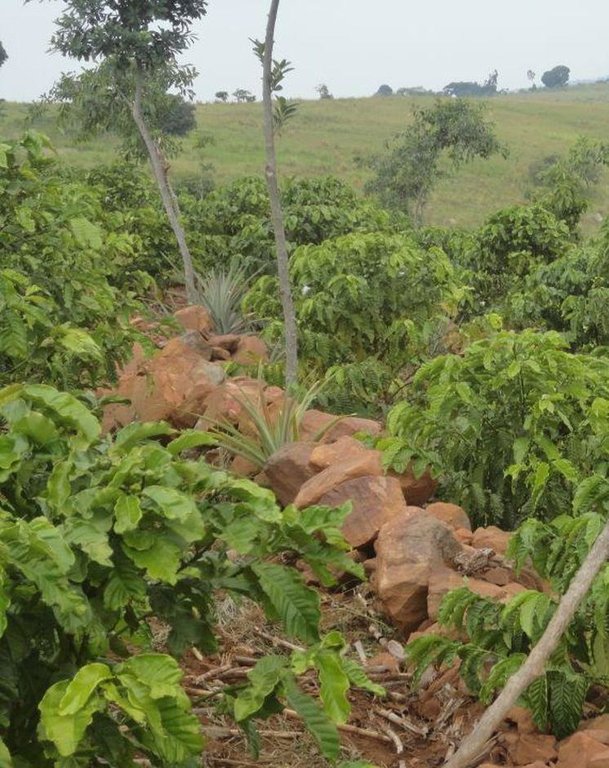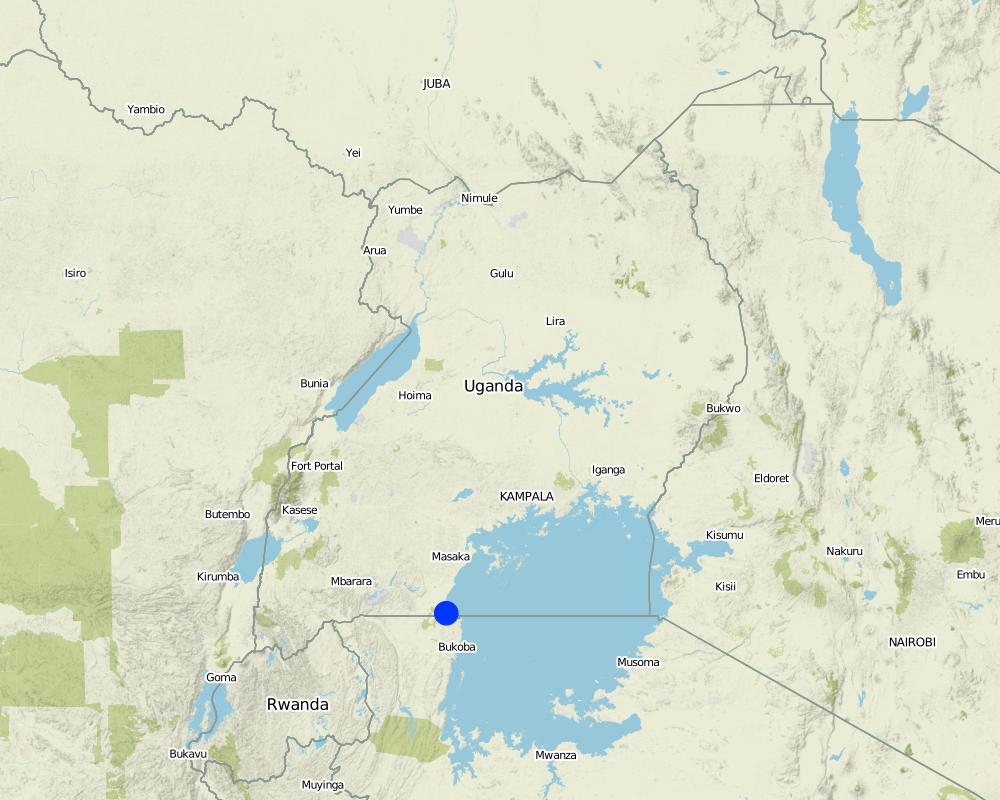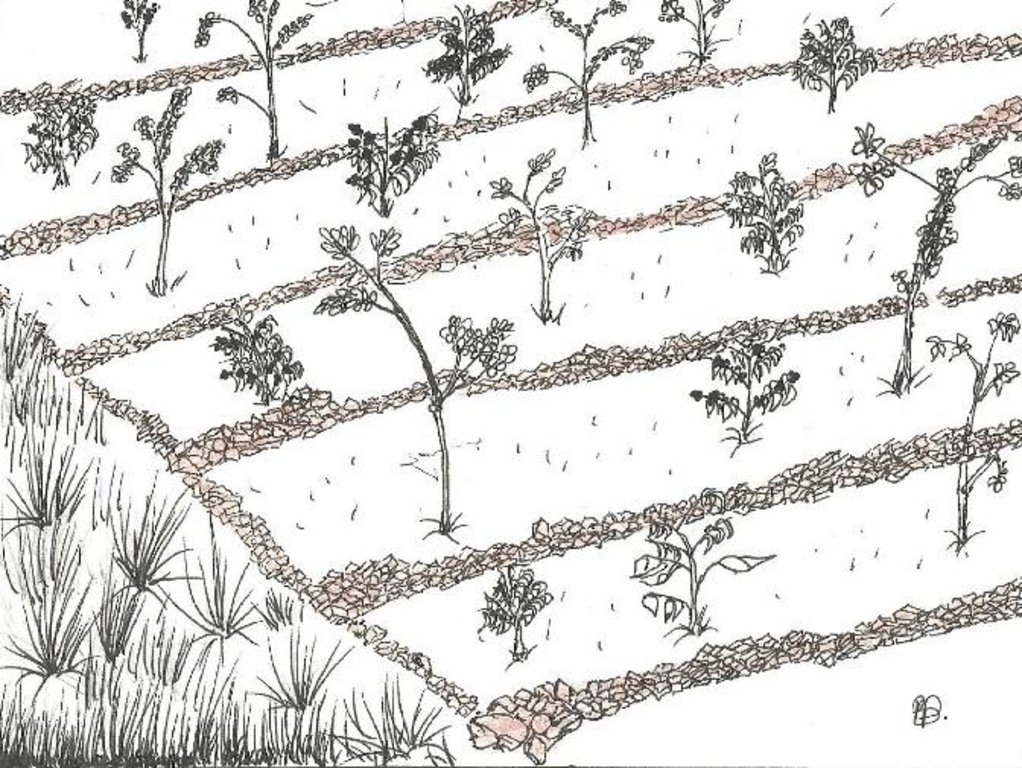Ficus Natalensis Agroforestry System [Uganda]
- Criação:
- Atualização:
- Compilador/a: Wilson Bamwerinde
- Editor: –
- Revisores: Fabian Ottiger, Alexandra Gavilano
Okusimba emituba n'ebimera
technologies_1153 - Uganda
Veja as seções
Expandir tudo Recolher tudo1. Informação geral
1.2 Detalhes do contato das pessoas capacitadas e instituições envolvidas na avaliação e documentação da tecnologia
Especialista em GST:
Especialista em GST:
Especialista em GST:
Lubega Emmanuel
Rakai district
Uganda
Nome do projeto que facilitou a documentação/avaliação da Tecnologia (se relevante)
The Transboundary Agro-ecosystem Management Project for the Kagera River Basin (GEF-FAO / Kagera TAMP )Nome da(s) instituição(ões) que facilitou(ram) a documentação/ avaliação da Tecnologia (se relevante)
Food and Agriculture Organization (FAO) - Itália1.3 Condições em relação ao uso da informação documentada através de WOCAT
O/a compilador/a e a(s) pessoa(s) capacitada(s) aceitam as condições relativas ao uso de dados documentados através da WOCAT:
Sim
1.5 Referência ao(s) questionário(s) sobre abordagens GST (documentado(s) usando WOCAT)

Community development appraoch [Uganda]
The approach involves the community and other development partners identifying opportunities, challenges and appropriate solutions through collective action.
- Compilador/a: Wilson Bamwerinde
2. Descrição da tecnologia de GST
2.1 Descrição curta da tecnologia
Definição da tecnologia:
Ficus natalensis based agroforestry system protects crops on windy hill slopes facing Lake Victoria and reduce runoff towards the meandering Kagera River Valley.
2.2 Descrição detalhada da tecnologia
Descrição:
Ficus natalensis is traditionally scattered in crop fields as a land management practice in central and south-western Uganda. The improved technology designed through community participation involves planting lines of Ficus natalensis along the contour at an interval that enables the tree to provide shade to young crops without depriving them of sunshine. When planted together with coffee trees or in banana plantations, the tall Ficus tree forms the top storey that protects the crop from the hot sun.
Purpose of the Technology: The main purpose of Ficus based agroforestry is to protect the soil from erosion. Within 3 to 5 years the Ficus tree forms a deep root system that stabilizes the soil. In addition, it drops leaves which quickly decay to provide both soil cover and manure thereby increasing the fertility of the soil. The trees provide firewood, fodder for livestock and bark cloth which can be used domestically or sold to supplement household income. They also act as wind breaks.
Establishment / maintenance activities and inputs: Ficus Natalensis is propagated using cuttings from young branches which are planted vertically 6 m apart along a contour. Propagation material is readily available and cheap, making the technology inexpensive to establish. Any annual or perennial crop can be inter-cropped with Ficus spp. provided the tree canopy is managed well. The tree is quite robust and can attain heights of over 20m, with a very extensive canopy if left to grow. Pruning raises its canopy to the desired height above the ground. In its early stages, fencing is required to protect the tree from damage by livestock. Within 12 to 18 months, however, the tree is established enough to withstand browsing. Only simple tools like hoes and garden forks for digging holes/pits are essential for establishment of the technology. The implementation of the technology on steep slopes (> 50%) is not possible without other supportive SLM interventions, in Rakai these include construction of stone lines and mulch application.
Natural / human environment: The pruned branches of Ficus natalensis are used as fuel wood when dry. Therefore scarcity of fuel wood may lead to over-harvesting of branches and destroying the canopy. Nonetheless, the tree regenerates quickly with the coming of the rains. Ficus tree can live for a hundred years.
2.3 Fotos da tecnologia
2.5 País/região/locais onde a tecnologia foi aplicada e que estão cobertos nesta avaliação
País:
Uganda
Região/Estado/Província:
Uganda
Especificação adicional de localização:
Rakai District (Kijonjo Parish)
Comentários:
Boundary points of the Technology area: -0.96681 31.69066; -0.96706 31.69111; -0.96717 31.69033; -0.96757 31.69038; -0.96774 31.69073
Total area covered by the SLM Technology is 0.06 km2.
The technology is becoming dominant in Kijonjo parish and other parts of Rakai district especially due to climatic changes that have led to shorter rainy seasons. However, farmers also recognize its potential for soil conservation.
Map
×2.6 Data da implementação
Caso o ano exato seja desconhecido, indique a data aproximada:
- menos de 10 anos atrás (recentemente)
2.7 Introdução da tecnologia
Especifique como a tecnologia foi introduzida:
- através de projetos/intervenções externas
Comentários (tipos de projeto, etc.):
Agroforestry is a traditional practice but was reintroduced in a better structured, systematic form by organizations like VI-Agroforestry and Kagera TAMP.
3. Classificação da tecnologia de GST
3.1 Principal/principais finalidade(s) da tecnologia
- Reduz, previne, recupera a degradação do solo
- Criar impacto econômico benéfico
3.2 Tipo(s) atualizado(s) de uso da terra onde a tecnologia foi aplicada

Terra de cultivo
- Cultura anual
- Cultura perene (não lenhosa)
- Cultura de árvores e arbustos
Cultivo anual - Especificar culturas:
- cereais - milho
- Legumes e leguminosas - feijão
Cultivo perene (sem lã) - Especificar culturas:
- banana/planta/abacá
Cultivo de árvores e arbustos - Especificar culturas:
- café, cultivado ao ar livre
- figos
- Ficus Spp.
Número de estações de cultivo por ano:
- 2
Especifique:
Longest growing period in days: 120 Longest growing period from month to month: February to May Second longest growing period in days: 120 Second longest growing period from month to month: September to December

Floresta/bosques
Produtos e serviços:
- Lenha
Comentários:
Major land use problems (compiler’s opinion): Severe deforestation as trees were cut down for firewood, charcoal, timber and for agricultural use;
Overgrazing
Major land use problems (land users’ perception): Prolonged dry weather, destructive rainstorms and declining soil fertility
Type of cropping system and major crops comments: Agro-forestry is used in combination with banana and coffee growing.
3.4 Abastecimento de água
Abastecimento de água para a terra na qual a tecnologia é aplicada:
- Precipitação natural
3.5 Grupo de GST ao qual pertence a tecnologia
- Agrofloresta
3.6 Medidas de GST contendo a tecnologia

Medidas agronômicas
- A7: Outros

Medidas vegetativas
- V1: cobertura de árvores/arbustos

Medidas estruturais
- S11: Outros
Comentários:
Main measures: vegetative measures
Specification of other agronomic measures: mulching (supp.
Specification of other structural measures: stone lines (supp.
Type of vegetative measures: aligned: -contour
3.7 Principais tipos de degradação da terra abordados pela tecnologia

Erosão do solo pela água
- Wt: Perda do solo superficial/erosão de superfície

Degradação biológica
- Bc: redução da cobertura vegetal
- Bq: quantidade/ declínio da biomassa
Comentários:
Main type of degradation addressed: Wt: loss of topsoil / surface erosion, Bc: reduction of vegetation cover, Bq: quantity / biomass decline
Main causes of degradation: soil management (Lack of conservation measures), crop management (annual, perennial, tree/shrub) (Over cultivation), deforestation / removal of natural vegetation (incl. forest fires) (Cutting trees for timber and opening up more agricultural land), over-exploitation of vegetation for domestic use (Cutting trees for fuel wood and charcoal), poverty / wealth, education, access to knowledge and support services
Secondary causes of degradation: other natural causes (avalanches, volcanic eruptions, mud flows, highly susceptible natural resources, extreme topography, etc.) specify (Steep and very steep slopes)
3.8 Redução, prevenção ou recuperação da degradação do solo
Especifique o objetivo da tecnologia em relação a degradação da terra:
- Reduzir a degradação do solo
4. Especificações técnicas, implementação de atividades, entradas e custos
4.1 Desenho técnico da tecnologia
Especificações técnicas (relacionada ao desenho técnico):
A diagram showing Ficus spp. trees planted to provide shade to coffee trees.
Location: Kijonjo B. village. Rakai
Date: 2013-12-05
Technical knowledge required for field staff / advisors: moderate (Knowledge of which trees will do well with the crops to be cultivated)
Technical knowledge required for land users: low (Land user dedication and a little guidance is enough for the implementation of the technology.)
Main technical functions: control of raindrop splash, control of dispersed runoff: impede / retard, improvement of ground cover, stabilisation of soil (eg by tree roots against land slides), reduction in wind speed, spatial arrangement and diversification of land use
Secondary technical functions: increase in organic matter, increase in nutrient availability (supply, recycling,…), increase of infiltration, increase / maintain water stored in soil, sediment retention / trapping, sediment harvesting, increase of biomass (quantity)
Aligned: -contour
Vegetative material: T : trees / shrubs
Number of plants per (ha): 250
Vertical interval between rows / strips / blocks (m): 20m
Spacing between rows / strips / blocks (m): 2m
Vertical interval within rows / strips / blocks (m): 2m
Width within rows / strips / blocks (m): 20m
Trees/ shrubs species: Ficus natalensis (also serves as perennial fodder), planted in the field using stem cuttings
Perennial crops species: Robusta coffee planted using seedlings bought from specialized nurseries
Slope (which determines the spacing indicated above): 35%
Autor:
Byonabye Proscovia, Kagera TAMP, Kabale
4.2 Informação geral em relação ao cálculo de entradas e custos
Outro/moeda nacional (especifique):
Ushs
Se for relevante, indique a taxa de câmbio do USD para moeda local (por exemplo, 1 USD = 79,9 Real): 1 USD =:
2500,0
Indique a média salarial da mão-de-obra contratada por dia:
2.00
4.3 Atividades de implantação
| Atividade | Periodicidade (estação do ano) | |
|---|---|---|
| 1. | Sourcing planting materials | Beginning of rains |
| 2. | Making pits | Beginning of rains |
| 3. | Planting cuttings | Wet season |
| 4. | Spot weeding | Wet season |
4.4 Custos e entradas necessárias para a implantação
| Especifique a entrada | Unidade | Quantidade | Custos por unidade | Custos totais por entrada | % dos custos arcados pelos usuários da terra | |
|---|---|---|---|---|---|---|
| Mão-de-obra | Sourcing planting materials | ha | 1,0 | 30,0 | 30,0 | 100,0 |
| Mão-de-obra | Making pits | ha | 1,0 | 30,0 | 30,0 | 100,0 |
| Mão-de-obra | Planting cuttings | ha | 1,0 | 8,0 | 8,0 | |
| Mão-de-obra | Spot weeding | ha | 1,0 | 8,0 | 8,0 | |
| Equipamento | 2 panga | ha | 1,0 | 8,0 | 8,0 | 100,0 |
| Equipamento | 2 hoes | ha | 1,0 | 8,0 | 8,0 | 100,0 |
| Material vegetal | Cuttings (500 stern cuttings) | ha | 1,0 | 30,0 | 30,0 | |
| Custos totais para a implantação da tecnologia | 122,0 | |||||
| Custos totais para o estabelecimento da Tecnologia em USD | 0,05 | |||||
Comentários:
Duration of establishment phase: 2 month(s)
4.5 Atividades recorrentes/manutenção
| Atividade | Periodicidade/frequência | |
|---|---|---|
| 1. | Spot weeding | twice a year |
| 2. | Pruning | Wet season |
| 3. | Removing and processing the bark into bark cloth | Once in 2 years |
4.6 Custos e entradas necessárias pata a manutenção/atividades recorrentes (por ano)
| Especifique a entrada | Unidade | Quantidade | Custos por unidade | Custos totais por entrada | % dos custos arcados pelos usuários da terra | |
|---|---|---|---|---|---|---|
| Mão-de-obra | Spot weeding | ha | 1,0 | 8,0 | 8,0 | 100,0 |
| Mão-de-obra | Pruning | ha | 1,0 | 8,0 | 8,0 | |
| Mão-de-obra | Removing and processing the bark into bark cloth | ha | 1,0 | 14,0 | 14,0 | |
| Equipamento | 1 panga | ha | 1,0 | 4,0 | 4,0 | 100,0 |
| Equipamento | 1 hoe | ha | 1,0 | 4,0 | 4,0 | |
| Custos totais para a manutenção da tecnologia | 38,0 | |||||
| Custos totais de manutenção da Tecnologia em USD | 0,02 | |||||
Comentários:
Machinery/ tools: The technology only requires simple tools like hoes and pangas.
The costs were calculated for wind breaks and optimum canopy after establishment. Calculations were done in December 2013, considering activities of the previous (September-November) wet season.
4.7 Fatores mais importantes que afetam os custos
Descreva os fatores mais determinantes que afetam os custos:
The most important factor affecting cost is labor to transport the bulky stem cuttings to the site. However, Ficus Natalensis is easy to establish and is durable (over 100 years) depending on management. It is extremely hardy and when it grows to 50cm to 100cm stem diameter it can be used for timber or to make dugout canoes. Establishment costs are easily recovered.
5. Ambiente natural e humano
5.1 Clima
Precipitação pluviométrica anual
- <250 mm
- 251-500 mm
- 501-750 mm
- 751-1.000 mm
- 1.001-1.500 mm
- 1.501-2.000 mm
- 2.001-3.000 mm
- 3.001-4.000 mm
- > 4.000 mm
Especificações/comentários sobre a pluviosidade:
The area receives two rainy seasons (March-May & September-December)
Zona agroclimática
- Subúmido
Thermal climate class: tropics. The area lies at the equator.
The area has a dry and a wet season, but other factors influencing its weather include proximity to Lake Victoria and the Kagera River.
5.2 Topografia
Declividade média:
- Plano (0-2%)
- Suave ondulado (3-5%)
- Ondulado (6-10%)
- Moderadamente ondulado (11-15%)
- Forte ondulado (16-30%)
- Montanhoso (31-60%)
- Escarpado (>60%)
Formas de relevo:
- Planalto/planície
- Cumes
- Encosta de serra
- Encosta de morro
- Sopés
- Fundos de vale
Zona de altitude:
- 0-100 m s.n.m.
- 101-500 m s.n.m.
- 501-1.000 m s.n.m.
- 1.001-1.500 m s.n.m.
- 1.501-2.000 m s.n.m.
- 2.001-2.500 m s.n.m.
- 2.501-3.000 m s.n.m.
- 3.001-4.000 m s.n.m.
- > 4.000 m s.n.m.
Indique se a tecnologia é aplicada especificamente em:
- Posições convexas
Comentários e outras especificações sobre a topografia:
Altitudinal zone: 1001-1500 m a.s.l (1269-1310m a.s.l.)
Slopes on average: Steep (ranked 1, while technology is good for all kind of slope, the description given here is for a steep slope) and hilly (ranked 2)
5.3 Solos
Profundidade do solo em média:
- Muito raso (0-20 cm)
- Raso (21-50 cm)
- Moderadamente profundo (51-80 cm)
- Profundo (81-120 cm)
- Muito profundo (>120 cm)
Textura do solo (solo superficial):
- Grosso/fino (arenoso)
- Médio (limoso, siltoso)
Matéria orgânica do solo superficial:
- Médio (1-3%)
Caso disponível anexe a descrição completa do solo ou especifique as informações disponíveis, p. ex. tipo de solo, PH/acidez do solo, nitrogênio, capacidade de troca catiônica, salinidade, etc.
Soil depth on average: Shallow (ranked 1) and very shallow (ranked 2). The technology has also adopted to moderate to deep soils to support root development of trees.
Soil texture: Coarse/light (ranked 1, 70% of the soil in the area is sandy) and medium (ranked 2, 20% of the soil is loamy)
Soil fertility: Medium
Topsoil organic matter: Medium (the organic matter is medium but has improved with agroforestry)
Soil drainage/infiltration: Good (soils are manly sandy)
Soil water storage capacity: Low (soils are predominantly sandy)
5.4 Disponibilidade e qualidade de água
Lençol freático:
5-50 m
Disponibilidade de água de superfície:
Precário/nenhum
Qualidade da água (não tratada):
Água potável precária (tratamento necessário)
Comentários e outras especificações sobre a qualidade e a quantidade da água:
Ground water table: 5-50 m (The technology does best in soils with ground table of 5-50m to enable root developement)
Availability of surface water: Poor/none (ranked 1, there is no surface water in dry season) and medium (ranked 2, some, in the wet season)
Water quality (untreated): Poor drinking water (treatement required, from unprotected source in swamps)
5.5 Biodiversidade
Diversidade de espécies:
- Médio
Comentários e outras especificações sobre biodiversidade:
While the surrounding valleys below are swampy and very rich in biodiversity, only a fraction remains at the slopes due to destruction of habitats.
5.6 Características dos usuários da terra que utilizam a tecnologia
Orientação de mercado do sistema de produção:
- Subsistência (autoabastecimento)
- misto (subsistência/comercial)
Rendimento não agrícola:
- Menos de 10% de toda renda
Nível relativo de riqueza:
- Média
- Rico
Indivíduos ou grupos:
- Indivíduo/unidade familiar
Nível de mecanização:
- Trabalho manual
Gênero:
- Mulheres
- Homens
Indique outras características relevantes dos usuários da terra:
Land users applying the Technology are mainly common / average land users
Difference in the involvement of women and men: n/a
Population density: 100-200 persons/km2
Annual population growth: 1% - 2%
21% of the land users are rich and own 57% of the land (Business men.).
63% of the land users are average wealthy and own 34% of the land (Teachers).
16% of the land users are poor and own 9% of the land (orphans and widows.).
Off-farm income specification: There is a difference in income levels between those who have implemented the technology and those who have not.
Level of mechanization: Manual work (only manual labour is used-casual labourers)
Market orientation: Subsistence (ranked 1, most produce is for home consumption only surplus is sold) and mixed (ranked 2)
5.7 Área média de terrenos utilizados pelos usuários de terrenos que aplicam a Tecnologia
- < 0,5 ha
- 0,5-1 ha
- 1-2 ha
- 2-5 ha
- 5-15 ha
- 15-50 ha
- 50-100 ha
- 100-500 ha
- 500-1.000 ha
- 1.000-10.000 ha
- > 10.000 ha
É considerado pequena, média ou grande escala (referente ao contexto local)?
- Pequena escala
Comentários:
Average area of land owned or leased by land users applying the Technology:
Ranked 1: 0.5-1 ha. For most average income families.
Ranked 2: <0.5-1ha. For the poor.
Ranekd 3: 1-2 ha. For the rich households.
5.8 Propriedade de terra, direitos de uso da terra e de uso da água
Propriedade da terra:
- Indivíduo, não intitulado
- Indivíduo, intitulado
Direitos do uso da terra:
- Indivíduo
Direitos do uso da água:
- Acesso livre (não organizado)
Comentários:
Most land users have access to untittled land and have open access to water.
5.9 Acesso a serviços e infraestrutura
Saúde:
- Pobre
- Moderado
- Bom
Educação:
- Pobre
- Moderado
- Bom
Assistência técnica:
- Pobre
- Moderado
- Bom
Emprego (p. ex. não agrícola):
- Pobre
- Moderado
- Bom
Mercados:
- Pobre
- Moderado
- Bom
Energia:
- Pobre
- Moderado
- Bom
Vias e transporte:
- Pobre
- Moderado
- Bom
Água potável e saneamento:
- Pobre
- Moderado
- Bom
Serviços financeiros:
- Pobre
- Moderado
- Bom
6. Impactos e declarações finais
6.1 Impactos no local mostrados pela tecnologia
Impactos socioeconômicos
Produção
Produção agrícola
Quantidade anterior à GST:
100
Quantidade posterior à GST:
400
Comentários/especificar:
coffee and bananas
Produção de madeira
Comentários/especificar:
For wood fuel (firewood & charcoal). there was almost nothing before.
Risco de falha de produção
Comentários/especificar:
conservation of moisture, improved soil fertility
Diversidade de produtos
Área de produção
Comentários/especificar:
Agricultural land on which Ficus is planted
Renda e custos
Rendimento agrícola
Comentários/especificar:
respondents reported increses in income but not documented.
Diversidade de fontes de rendimento
Carga de trabalho
Comentários/especificar:
Realization of the benefits has led many farmers to need more help therefore raising the cost of labour
Impactos socioculturais
Segurança alimentar/auto-suficiência
Comentários/especificar:
incresed agricultural produce.
Oportunidades culturais
Comentários/especificar:
backcloth is used for cultural functions .eg. burying the dead.
Atenuação de conflitos
Improved livelihoods and human well-being
Comentários/especificar:
The technology has improved availability of both food and fuel wood. Some products from trees used in agroforestry such as backcloth (Embugo - Luganda) are sold, diversifying household income.
Impactos ecológicos
Ciclo hídrico/escoamento
Escoamento superficial
Evaporação
Solo
Umidade do solo
Cobertura do solo
Perda de solo
Matéria orgânica do solo/carbono abaixo do solo
Comentários/especificar:
dried tree leaves add humus and organic matter in the soil.
Biodiversidade: vegetação, animais
Biomassa/carbono acima do solo
Diversidade vegetal
Comentários/especificar:
various tree species are used for agroforestry.
Espécies benéficas
Diversidade de habitat
Controle de praga/doença
Clima e redução de riscos de desastre
Deslizamentos de terra/fluxos de escombros
Comentários/especificar:
Prevention of predisposition towards landslides
Velocidade do vento
Comentários/especificar:
windbreaks reduced wind velocity.
Outros impactos ecológicos
Risk of lightening strikes
6.2 Impactos externos mostrados pela tecnologia
Cheias de jusante
Sedimentação a jusante
Poluição de água subterrânea/rio
Danos em áreas vizinhas
6.3 Exposição e sensibilidade da tecnologia às mudanças climáticas graduais e extremos/desastres relacionados ao clima (conforme o ponto de vista dos usuários da terra)
Mudança climática gradual
Mudança climática gradual
| Estação do ano | aumento ou diminuição | Como a tecnologia lida com isso? | |
|---|---|---|---|
| Temperatura anual | aumento | bem |
Extremos (desastres) relacionados ao clima
Desastres meteorológicos
| Como a tecnologia lida com isso? | |
|---|---|
| Temporal local | não conhecido |
| Tempestade de vento local | bem |
Desastres climatológicos
| Como a tecnologia lida com isso? | |
|---|---|
| Seca | bem |
Desastres hidrológicos
| Como a tecnologia lida com isso? | |
|---|---|
| Inundação geral (rio) | não conhecido |
Outras consequências relacionadas ao clima
Outras consequências relacionadas ao clima
| Como a tecnologia lida com isso? | |
|---|---|
| Período de crescimento reduzido | bem |
6.4 Análise do custo-benefício
Como os benefícios se comparam aos custos de implantação (do ponto de vista dos usuários da terra)?
Retornos a curto prazo:
positivo
Retornos a longo prazo:
positivo
Como os benefícios se comparam aos custos recorrentes/de manutenção(do ponto de vista dos usuários da terra)?
Retornos a curto prazo:
muito positivo
Retornos a longo prazo:
muito positivo
Comentários:
The costs for both establishment and maintenance are a small fraction of the benefits accruing from the technology.
6.5 Adoção da tecnologia
Se disponível, determine a quantidade (número de unidades familiares e/ou área abordada):
8
De todos aqueles que adotaram a Tecnologia, quantos o fizeram espontaneamente, ou seja, sem receber nenhum incentivo/ pagamento material?
- 91-100%
Comentários:
100% of land user families have adopted the Technology without any external material support
8 land user families have adopted the Technology without any external material support
Comments on spontaneous adoption: There is spontaneous adoption of the technology as it builds on traditional farming practices in the area.
There is a strong trend towards spontaneous adoption of the Technology
Comments on adoption trend: High demand for shade-grown coffee and bananas in addition to the highly valued bark cloth used in art and crafts has increased farmer appreciation.
6.7 Pontos fortes/vantagens/oportunidades da tecnologia
| Pontos fortes/vantagens/oportunidades na visão do usuário da terra |
|---|
|
Ficus is used to provide backcloth that is sold for the making of Art and crafts and for cultural functions. How can they be sustained / enhanced? Management to accelerate healing of the bark within a shorter period should be investigated |
|
Trees shield crops from dangerous storms /rains and intense sunshine. How can they be sustained / enhanced? Encourage the spread of the canopy |
|
Ficus is good and attractive to birds and insects How can they be sustained / enhanced? Provision of material support in form of seedlings, farm tools for accelerated multiplication |
|
Ficus natalensis leaves are cut and fed to livestock like goats. How can they be sustained / enhanced? Encourage indeginous trees and growing fodder crops such as calliandra and nappier grass |
| Pontos fortes/vantagens/oportunidades na visão do/a compilador/a ou de outra pessoa capacitada |
|---|
|
Demand for wood fuel is high How can they be sustained / enhanced? Local bye laws should be enacted to control deforestation and encourage tree growing |
|
It improves soil fertility-Ficus natalensis sheds leaves once every year, adding to soil humus. How can they be sustained / enhanced? More guidance should be given to the farmers for sustained spontaneous adoption of the technology |
|
It checks the speed of wind thereby protecting crops. How can they be sustained / enhanced? Other agricultural, ecological and social benefits could be explored in this scenic area facing the Kagera River where it enters Lake Victoria |
|
Stakes made from the Ficus branches can be used to grow climbing plants eg. passion fruits, yams as well as climbing beans How can they be sustained / enhanced? More tree planting should be encouraged |
|
Prevents soil erosion by checking raindrop splash, speed and amount of surface runoff and stabilizes the soil. How can they be sustained / enhanced? Because the ficus tree takes time to establish, other technologies such as trenches and grass strips could be used to reinforce it |
6.8 Pontos fracos, desvantagens/riscos da tecnologia e formas de superá-los
| Pontos fracos/desvantagens/riscos na visão do usuário da terra | Como eles podem ser superados? |
|---|---|
| The trees can hinder crops from light if canopy is dense | Prune periodically to enable other crops access to light |
| Some trees can fall especially during heavy and stormy rains, damaging plants and animals. | cutting excessive branches to reduce the load borne by trees. |
| Trees can attract lightening ,which destroys plants and animals. | Avoid putting animals under tall trees. |
| Pontos fracos/vantagens/riscos na visão do/a compilador/a ou de outra pessoa capacitada | Como eles podem ser superados? |
|---|---|
| Some tree species especially with short roots , compete with crops for nutrients. | Planting tree species with deep roots to avoid competition for nutrients. |
| It is a home for weaver birds and caterpillars. | Use scarecrows and biological control. |
7. Referências e links
7.1 Métodos/fontes de informação
7.2 Referências às publicações disponíveis
Título, autor, ano, ISBN:
Kagera TAMP project website
Disponível de onde? Custos?
http://www.fao.org/nr/kagera/en/
Links e módulos
Expandir tudo Recolher tudoLinks

Community development appraoch [Uganda]
The approach involves the community and other development partners identifying opportunities, challenges and appropriate solutions through collective action.
- Compilador/a: Wilson Bamwerinde
Módulos
Não há módulos


